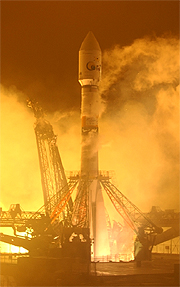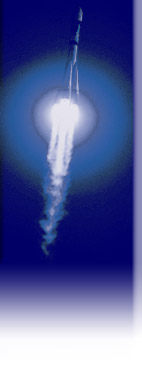The enhanced Soyuz 2-1b orbits Europe's COROT astronomy satellite on its maiden launch
December 27, 2006
The upgraded Soyuz 2-1b vehicle performed its successful inaugural flight today, orbiting the COROT astronomy satellite and marking a key milestone in the evolution of Russia's workhorse launcher.
 |
The Soyuz 2-1b is seconds away
from launch as its engines are
throttled up to liftoff power. |
|
After lifting off from Baikonur Cosmodrome in Kazakhstan at 8:23 p.m., the Soyuz 2-1b deployed COROT at the completion of a 50-minute mission, placing the 630-kg. satellite into a circular polar orbit.
This flight was carried out under the joint responsibility of Starsem and its Arianespace affiliate, and it was the 1,717th launch of a Soyuz-series vehicle. COROT was booked by Arianespace specifically to be orbited by Soyuz, demonstrating the company's mission flexibility with its growing family of launch vehicles.
The Soyuz 2-1b vehicle incorporates a more powerful third stage engine, which represents the latest step in a cooperative European/Russian program to evolve Soyuz – which subsequently will be introduced by Arianespace in commercial operations from Europe's Spaceport in French Guiana.
Today's Soyuz 2-1b mission builds on the successful introduction of the improved Soyuz 2-1a launcher, which has flown three times. The initial Soyuz 2-1a flight occurred in November 2004 from Russia's Plesetsk Cosmodrome, and was followed by Starsem's utilization of the vehicle to orbit the MetOp-A meteorological satellite last October from Baikonur Cosmodrome. Another Soyuz 2-1a mission was performed several days ago, when a Russian government payload was launched from Plesetsk Cosmodrome on December 24.
The Soyuz 2-1a version implements a digital control system that gives increased mission flexibility, and also provides for the additional launch vehicle flight control required when the new, enlarged Soyuz ST payload fairing is used. These improvements are carried over to the Soyuz 2-1b, which is further enhanced with its increased-performance third stage engine.
When the improved Soyuz enters service at the Spaceport, this launcher will become the reference medium-class vehicle for governmental and commercial missions – joining the proven heavy-lift Ariane 5 that already is in service, as well as the lightweight Vega, which currently is advancing through its development phase.
Starsem Chairman & CEO Jean-Yves Le Gall, who also is the CEO of Arianespace, said COROT's successful orbiting demonstrates the benefits of the companies' launcher family approach. "With Ariane 5 and Soyuz, we have marked one of our best operational years," he explained. "The five Ariane 5 missions and two Soyuz launches we performed in 2006 orbited no less than 12 satellites."
The COROT payload lofted by Soyuz 2-1b today is a development of the French CNES national space agency, which organized an international scientific effort involving France, Austria, Spain, Germany, Brazil and the European Space Agency. Produced by Alcatel Alenia Space, COROT is a pioneering satellite designed to study the vibratory performance of stars to determine their internal structure, age and composition. Data from the spacecraft also will be used to seek out new planets, possibly confirming the existence of telluric celestial bodies with physical properties comparable to the Solar System's own rocky planets.
During the Soyuz 2-1b's flight, its re-ignitable Fregat upper stage made two burns to carry COROT to its circular polar orbit. The propulsion system's initial firing was followed by a coast phase of approximately 35 minutes. A second Fregat burn was performed, with COROT then deployed from the upper stage.







